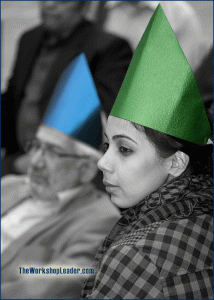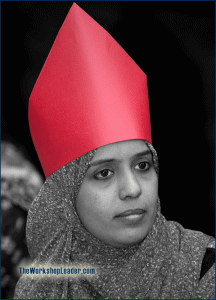The world as we have created it is a process of our thinking. It cannot be changed without changing our thinking.
Albert Einstein (1879—1955)
German theoretical physicist
The Six Thinking Hats by the international best-selling author Edward de Bono (*1933) is primarily an analytical tool but you can also use it to moderate discussions, in meetings as well as for brainstorming.
The six hats
The basic idea is that there are six hats of different colours. Everybody wearing a certain hat is bound to think and speak only according to a defined role. Some examples are provided here:

White Hat
(association: paper, neutrality): focuses on information. What information do we have or do we need? How are we getting the information we need? People wearing white hats should play the role of a computer that only gives out hard facts and not opinions. The moderator must pay attention to separate hard facts from likelihoods, assumptions and beliefs.
Red Hat
(association: fire, love): expresses his or her feelings about something. There is no need to give reasons or to explain. So, it’s the opposite to white and the moderator accepts only emotions.
Black Hat
(association: darkness, paint a black picture): is cautious. Why does something not work? What are the difficulties and problems? The black hat assigns a role of someone who considers risks and dangers plus keep values and ethics in proposed actions.
Yellow Hat
(association: sunshine, optimism): thinks positively. Those in yellow hats should focus on possibilities and benefits as well as making constructive suggestions! How will things be possible? What is the best possible scenario?
Green Hat
(association: nature, growth): thinks creatively. Come up with new ideas, new concepts and new perceptions. What are the alternatives? How will change be possible? The green hat will give its wearer the obligation to try out new approaches to existing problems, switch patterns and try some humour.
Blue Hat
(association: sky, overview) is the bird’s-eye view, the Meta level. You look down on the little things on earth and take into account the other hats. You control the thinking process. You are the conductor of an orchestra. You ask the right questions and give thinking tasks.
Discipline is very important here: the moderator supervises and allows an individual to discuss only the topic, which is related to the hat, he is wearing.
Of course you can just imagine the hat, but it’s more fun in groups to really wear them. Also, this helps with learning and remembering the topics discussed.
It’s useful to set timing for the whole session but also for each hat. The moderator can assign colours in order to challenge somebody’s character and thus create a better understanding of other people’s way of thinking and acting. You could use it in sequence (one hat after the other) or, alternatively, participants can choose themselves.
For more information on the Six Thinking Hats you can visit the website of its inventor Edward de Bono at www.edwdebono.com. Besides that he has invented other techniques and by his books and lectures he enhances more creativity in life and better thinking. The British doctor has established a company where you can book courses in creativity and thinking: www.debonogroup.com.
You might also check the suitability of the following tools:
[child_pages siblings=”true” link_titles=”true” title_link_class=”my_title_link_class” truncate_excerpt=”false” words=”20″ class=”myclass”]

